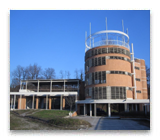Tests and surveys
Concrete surveys
Ultrasound using direct, semi-direct, indirect transmission
The mechanical characteristics of the concrete, in particular its homogeneity, are determined by ultrasound. To carry out the test, the emitting probe and the receiving probe are placed on both sides of the element to be investigated (or on the same surface if the opposite surface is not accessible). The emitting probe produces pulses that are picked up by the receiving probe and recorded by the equipment. The transit time, being proportional to the mechanical resistance of the concrete, gives an indication of the variation in resistance at different points.
Evaluation of concrete resistance using Pull-Out
The pull-out technique used to determine the mechanical properties of in-situ concrete. The method consists of inserting a steel dowel of standard shape into the concrete and extracting it using suitable equipment. The value of the extraction force, compared with an experimental correlation curve, makes it possible to evaluate the strength of the concrete.
Concrete resistance evaluation using Sclerometer
Sclerometric testing is used to estimate the compressive strength of concrete on structures already built. The Sclerometer uses the measurement of the rebound of a steel cylinder that hits the surface of the concrete with a constant force caused by a spring. For a more definite evaluation of the experimental data we recommend the use of the paper tape measure that allows the recording of the measured values.
Evaluation of concrete resistance using the Windsor method
The purpose of the test is to determine the strength of the concrete depending on the aggregate used in the casting and the resistance to penetration by a steel probe which penetrates about 4 cm into the interior subjected to ballistic thrust. In order to obtain the average compressive strength, the values relating to the average length of penetration of the probe and the surface hardness measurement on the Mohs scale should be read on the correlation table.
Assessment of the depth of the carbonation
The purpose of the test is to determine the depth of carbonation of the surface layer of the concrete. Concrete has a pH value of about 12.5, which gives it a strongly alkaline character. This strong alkalinity is natural protection of the reinforcement against corrosion. Carbonate concrete is highly permeable and reduces in protective capacity; it also provides superior hardness that tends to deceive the methods of determining compressive strength measured using a sclerometer.
Core drilling
The purpose of this survey is to provide the laboratory with the specimen to be subjected to a compression test to determine its strength and to calibrate the results obtained by non-destructive methods. From the extracted substrate it is also possible to obtain the elastic modulus and the thickness of the carbonation.
Evaluation of concrete resistance using Speedymet
The Speedymet is a device capable of determining the predictable resistance of the concrete to 28 days within a few hours of casting. The equipment has been designed to be left directly on site, allowing all the necessary steps to be carried out to obtain a 28-day resistance forecast: rapid curing of the concrete, compression of the samples, printing of the test reports. The test is performed on at least 2 8 x 8 x 8 cm samples. The test is performed on at least 2 8 x 8 x 8 cm samples.
Tension measurement using Strain-Gauges (strain gages)
The purpose of the test is to measure the tensional state of the concrete structural elements by mounting a pair of diametrically opposed sensors so that the combined tensional state of axial stress and bending moment can be measured.
Endoscopic surveys
The aim of the endoscope survey is to classify in detail the consistency and nature of the material making up the structure under examination, by means of visual and photographic surveys For this purpose, a probe is used which is inserted into some holes in the concrete made by a core drill or electric drill. The photographic or video feedback from the inspection allows any anomalies and cavities inside the concrete to be detected.
Quantitative analysis of ion-chlorine
The purpose of the test is to calculate the amount of ion chloride present in a concrete sample. The guidelines of the Technical Service of the Ministry of Infrastructure indicate as control parameters for the durability of structures that the concentration of ion-chlorides, expressed as a percentage by weight of the cement content, is below the critical threshold of 0.2%, a value that prevents the reaction that regulates the corrosion of the reinforcement.
Evaluations using the SonReb method
The purpose of the test is to calculate the average compressive strength of the concrete by combining the ultrasonic speed V, obtained from ultrasonic tests, with the rebound index S obtained by sclerometric tests, compensating for the errors of both tests. The moisture content and the age of the concrete actually influence both tests in the opposite way. Experimental or, alternatively, analytical correlation curves are used.
Measurement of the adhesion strength of the coating (Pull-Off)
The purpose of the test is to identify the adhesion strength of any material (plaster, mortar, cast and paints) on a surface by calculating it from the tensile strength of some anchor bolts. The equipment used consists of a hydraulically operated force multiplier and a dynamometer that stores the force required to tear off the part of the surface cut and glued to the anchoring dowel.
Mantua
Diagnostic surveys on the materials and internal structures of a school located in the province of Mantua.
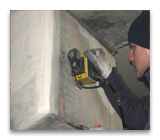
Padua
Experimental surveys on reinforced concrete pillars, aimed at verifying the integrity of the shelves.
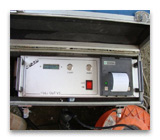
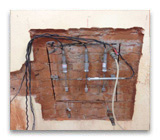
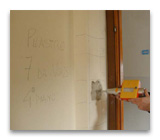
Venice
Experimental surveys on materials of civil structure using a sclerometer, Pull Out equipment and ultrasonic detector.
